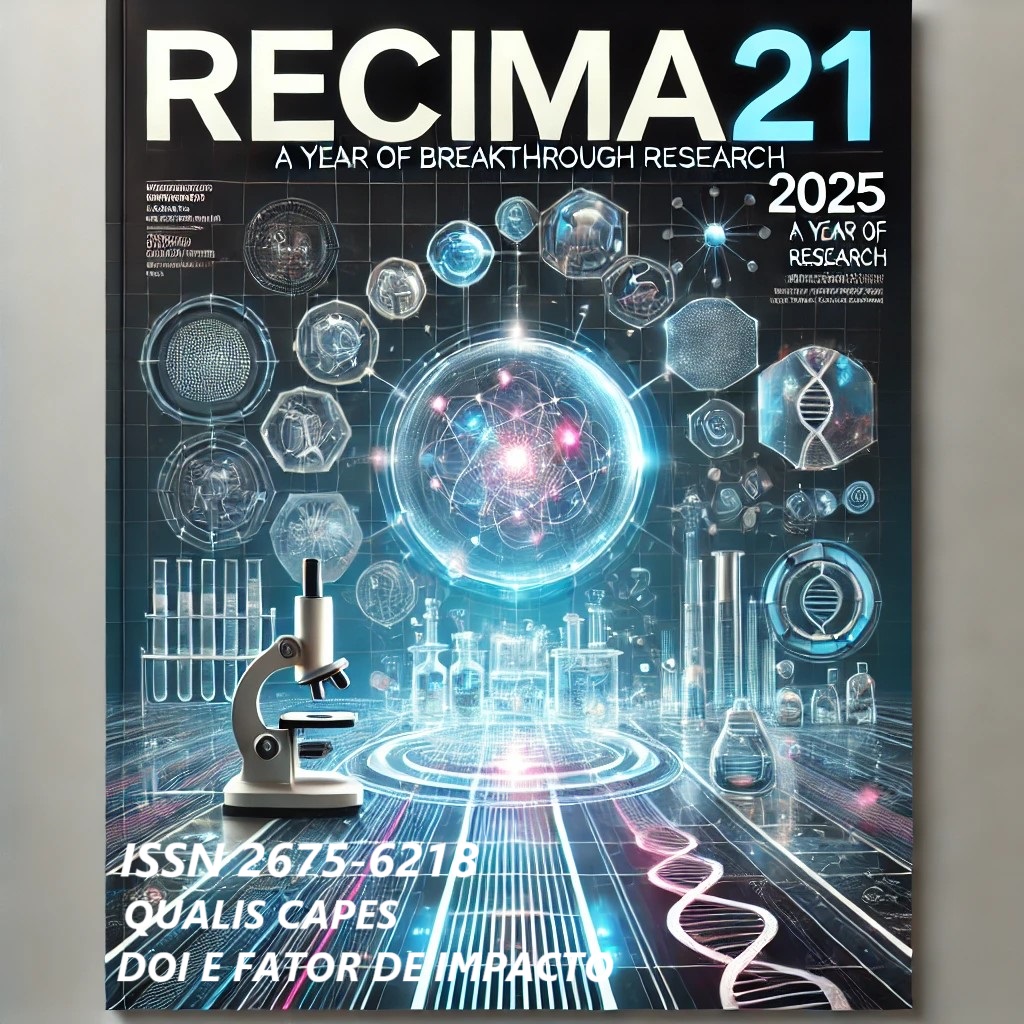COMPARISON OF THE CHEMICAL PROFILE OF OREGANO (Origanum vulgare) DECOCTS PREPARED AT DIFFERENT EXTRACTION TIMES FROM OVEN-DRIED SAMPLES AND IN NATURAL CONDITIONS
DOI:
https://doi.org/10.47820/recima21.v6i6.6534Keywords:
Origanum vulgarum. ESI-MS. Chemical profile.Abstract
In addition to their food and flavour properties, some spices also contain bioactive substances. Most of these spices are marketed dehydrated to increase their shelf life and reduce storage and transport costs. However, care must be taken to ensure that the dehydration process does not cause alterations to the chemical profile, affecting its pharmacological properties. Considering the widespread use of dehydrated oregano leaves in the preparation of teas, this study investigated whether the drying method and decoction time during extraction could alter the chemical profile of the extracts. Oregano samples were dried in ambient conditions and in an oven at 40oC. From each of the dehydrated materials, aqueous extracts were prepared by decoction, varying the heating time. The decoctions were then analysed by Electrospray Ionisation Mass Spectrometry (ESI-MS) in both positive and negative modes. It was observed that applying different drying methods resulted in samples with different chemical profiles, while varying the extraction time for samples obtained using the same drying method did not lead to significant variations. In the spectra obtained from the leaves dried under ambient conditions, the most intense signals found correspond to rosmarinic acid (m/z=359), which has pharmacological properties, and aristolochic acid (m/z= 381), which has toxic properties. In the decoctions obtained from oven-dried leaves, the main metabolite was quinic acid, an important precursor of chlorogenic acids (m/z=191).
Downloads
References
BENALI, T.; BAKRIM, S.; GHCHIME, R.; BENKHAIRA, N.; EL OMARI, N.; BALAHBIB, A.; BOUYAHYA, A. Pharmacological insights into the multifaceted biological properties of quinic acid. Biotechnology and Genetic Engineering Reviews, v.40, n.4, p.3408-34371, 2024. DOI: https://doi.org/10.1080/02648725.2022.2122303
DUBOIS M.; BAILLY, F.; MBEMBA, G.; MOUSCADET, J. F.; DEBYSER, Z.; WITVROUW, M.; COTELLE, P. REACTION of rosmarinic acid with nitrite ions in acidic conditions: discovery of nitro- and dinitrorosmarinic acids as new anti-HIV-1 agents. J Med Chem., v. 51, n. 8, p. 2575-9, 24 Apr. 2008. DOI: https://doi.org/10.1021/jm7011134
FARIA, B.; BISPO, C.; CORDEIRO, M.; BALTAZAR, A. Ácido aristolóquico - nefropatia e o cancro. Acta Portuguesa de Nutrição, v. 24, p. 70-5, 2021. DOI: https://doi.org/10.21011/apn.2021.2413
GREVSEN, K.; FRETTÉ, X. C.; CHRISTENSEN, L. P. Content and composition of volatile terpenes, flavonoids and phenolic acids in Greek oregano (Origanum vulgare L. ssp. hirtum) at different development stages during cultivation in cool temperate climate. Europ. J. Hort. Sci., v. 74, n. 5, S. 193–203, 2009. DOI: https://doi.org/10.1079/ejhs.2009/1182840
HUANG, S. S.; ZHENG, R. L. Rosmarinic acid inhibits angiogenesis and its mechanism of action in vitro. Cancer Lett., v. 239, n. 2, p. 271-280, 2006. DOI: https://doi.org/10.1016/j.canlet.2005.08.025
KHALEEL, C.; NURHAYAT, T.; BUCHBAUER, G. α-Terpineol, a natural monoterpene:A review of its biological properties. Open Chemistry, v. 16, n. 1, p.349-361, 2018. DOI: https://doi.org/10.1515/chem-2018-0040
KIKUZAKI, H.; AKATANI, N. N. Structure of a new anti-oxidative phenolic acid from oregano (Origanum vulgare L.). Agric. Biol. Chem., v. 53, p. 519–524, 1989. DOI: https://doi.org/10.1271/bbb1961.53.519
KLIMIENĖ, A.; KLIMAS, R.; SHUTAVA, H.; RAZMUVIENĖ, L. Dependence of the concentration of bioactive compounds in Origanum vulgare on Chemical Properties of the Soil. Plants, v. 10, p. 750, 2021. DOI: https://doi.org/10.3390/plants10040750
KOŞAK, C. B. M. R.; GÖGER, F. In vitro antioxidant properties and phenolic composition of Phenolic compounds prevent amyloid B protein oligomerization and synaptic dysfunction by site-specific binding Salvia virgata Jacq. from Turkey. J. Agric. Food Chem., v. 56, n. 7, p. 2369-2374, 2008. DOI: https://doi.org/10.1021/jf073516b
LORENZI, H.; MATOS, F. J. A. Plantas medicinais no Brasil: nativas e exóticas cultivadas. Nova Odessa, SP: Editora Plantarum, 2021. 576 p.
MORENO S.; SCHEYER T.; ROMANO C. Antioxidant and antimicrobial activities of rosemary extracts linked to their polyphenol composition. Free Radic. Res, v. 40, p. 223-231, 2006. DOI: https://doi.org/10.1080/10715760500473834
ONO, K.; LI, L.; TAKAMURA, Y.; YOSHIIKE, Y.; ZHU, L.; HAN, F.; MAO, X.; IKEDA, T.; TAKASAKI, J.; NISHIJO, H.; TAKASHIMA, A.; TEPLOW, D. B.; ZAGORSKI, M. G.; YAMADA, M. Phenolic compounds prevent amyloid β-protein oligomerization and synaptic dysfunction by site-specific binding. J Biol Chem., v. 287, n. 18, p. 14631-43, 27 apr. 2012. DOI: https://doi.org/10.1074/jbc.M111.325456
OSAKABE, T. Y, N.; YASUDA, A.; NATSUME, M. Rosmarinic acid inhibits epidermal inflammatory responses: anticarcinogenic effect of Perilla frutescens extract in the murine two-stage skin model. Carcinogenesis, v. 25, n. 4, p.549-557, 2004. DOI: https://doi.org/10.1093/carcin/bgh034
RODRIGUES, V. G. S. Cultivo, uso e manipulação de plantas medicinais. Porto Velho, RO: Embrapa, 2004. 25 p.
SIRAJUDEEN, F; MALHAB, L. J. B.; BUSTANJI, Y. Exploring the Potential of Rosemary Derived Compounds (Rosmarinic and Carnosic Acids) as Cancer Therapeutics: Current Knowledge and Future Perspectives. Biomol Ther., v. 32, n. 1, p. 38-55, 2024. DOI: https://doi.org/10.4062/biomolther.2023.054
SKOUFOGIANNI, F.; SOLOMOU, A. D.; DANALATOS, N. G. Ecology, Cultivation and Utilization of the Aromatic Greek Oregano (Origanum vulgare L.): A Review. Not Bot Horti Agrobo, v. 47, n. 3, p. 545-552, 2019. DOI: https://doi.org/10.15835/nbha47311296
SOLTANI, S.; SHAKERI, A.; IRANSHAHI, M. Review of the Phytochemistry and Antimicrobial Properties of Origanum vulgare L. and Subspecies. Iranian Journal of Pharmaceutical Research., v. 20, n. 2, p. 268-285, 2021.
SULAIMAN, G. M.; MESSAOUDI, S.; MOHAMMED, H. A.; KHAN, F. A.; EMWAS, A. H.; ELRAOUF, M. A.; EL-GHALY, EL-S.M.; ALMAHMOUD, A. S.; AROUA, L.. M.; RAGAB, E. A. Thymoquinol-2-O-β-D-glucopyranoside: Isolation from Pulicaria Jaubertii, Anticancer Efficacy, and Comparative Apoptotic Markers Binding Studies with Thymoquinone and Thymoquinol. Chemistry Select., v. 10, n. 14, 2025. disponível em: https://doi.org/10.1002/slct.202500551. Acesso em: 01 maio 2025. DOI: https://doi.org/10.1002/slct.202500551
TAKANO, H.; OSAKABE, N.; SANBONGI, C.; YANAGISAWA, R.; INOUE, K.; YASUDA, A.; NATSUME, M.; BABA, S.; ICHIISHI, E.; YOSHIKAWA, T. Extract of Perilla frutescens enriched for rosmarinic acid, a polyphenolic phytochemical, inhibits seasonal allergic rhinoconjunctivitis in humans. Exp Biol Med., (Maywood). 2004. DOI: https://doi.org/10.1177/153537020422900305
TAKEDA, T. M. H.; TSUJI, M.; INAZU, M.; EGASHIRA, T. Rosmarinic acid and caffeic acid produce antidepressive-like effect in the forced swimming test in mice. Eur. J. Pharmacol., v. 449, n. 3, p. 261-267, 2002. DOI: https://doi.org/10.1016/S0014-2999(02)02037-X
ZEJLI, H.; METOUEKEL, A.; ZOUIRECH, O.; MALIKI, I.; EL-MOUSSAOUI, A.; LFITAT, A.; BOUSSERAF, F. Z.; ALMAARY, K. S.; NAFIDI, H-A.; KHALLOUKI, F.; BOURHIA, M.; TALEB, M.; ABDELLAOUI, A. Phytochemical analysis, antioxidant, anti-inflamatory, hemagglutinin and hemolytic activities of chemically characterized extracts from Origanum grossi (L.) and Thymus pallidus (L.). Plants, v. 13, p. 385, 2024. DOI: https://doi.org/10.3390/plants13030385
ZHANG J.-J.; WANG Y.-L.; FENG X.-B.; SONG X.-D.; LIU W.-B. Rosmarinic acid inhibits proliferation and induces apoptosis of hepatic stellate cells. Biol. Pharm. Bull., v. 34, n. 3, p. 343-348, 2011. DOI: https://doi.org/10.1248/bpb.34.343
Downloads
Published
License
Copyright (c) 2025 RECIMA21 - Revista Científica Multidisciplinar - ISSN 2675-6218

This work is licensed under a Creative Commons Attribution 4.0 International License.
Os direitos autorais dos artigos/resenhas/TCCs publicados pertecem à revista RECIMA21, e seguem o padrão Creative Commons (CC BY 4.0), permitindo a cópia ou reprodução, desde que cite a fonte e respeite os direitos dos autores e contenham menção aos mesmos nos créditos. Toda e qualquer obra publicada na revista, seu conteúdo é de responsabilidade dos autores, cabendo a RECIMA21 apenas ser o veículo de divulgação, seguindo os padrões nacionais e internacionais de publicação.













